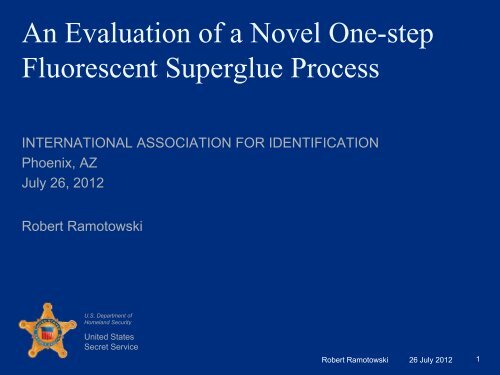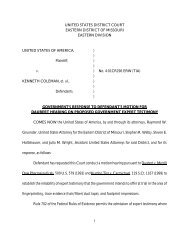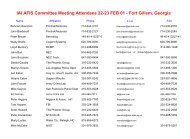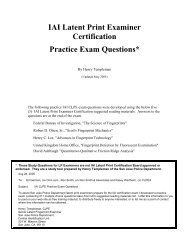An Evaluation of a Novel One-step Fluorescent ... - Onin.com
An Evaluation of a Novel One-step Fluorescent ... - Onin.com
An Evaluation of a Novel One-step Fluorescent ... - Onin.com
You also want an ePaper? Increase the reach of your titles
YUMPU automatically turns print PDFs into web optimized ePapers that Google loves.
<strong>An</strong> <strong>Evaluation</strong> <strong>of</strong> a <strong>Novel</strong> <strong>One</strong>-<strong>step</strong><strong>Fluorescent</strong> Superglue ProcessINTERNATIONAL ASSOCIATION FOR IDENTIFICATIONPhoenix, AZJuly 26, 2012Robert RamotowskiU.S. Department <strong>of</strong>Homeland SecurityUnited StatesSecret ServiceRobert Ramotowski 26 July 20121
DISCLAIMERThe views expressed by the author <strong>of</strong> thispresentation are personal and do not reflect any<strong>of</strong>ficial position or re<strong>com</strong>mendation by the U.S. SecretService. In addition, all references pertaining tomanufacturers and their products are provided forillustrative purposes only and their inclusion does notimply endorsement by either the author or by the U.S.Secret Service.U.S. Department <strong>of</strong>Homeland SecurityUnited StatesSecret ServiceRobert Ramotowski 26 July 20122
BackgroundU.S. Department <strong>of</strong>Homeland SecurityUnited StatesSecret ServiceRobert Ramotowski 26 July 20123
Background• Dr. Harry Coover was the first to work with cyanoacrylate monomersin 1942 while searching for the best material for making clear gunsights – he rejected the material initially because it was too sticky• Cyanoacrylates also synthesized by Ardis in 1949• First discovery <strong>of</strong> the strong adhesive properties was in 1951• Joyner and Shearer (working for Coover at Eastman) accidentlybonded the glass prisms <strong>of</strong> a refractometer together• This material (ethyl cyanoacrylate) was subsequently marketed asEastman 910 and ultimately as Superglue in 1958U.S. Department <strong>of</strong>Homeland SecurityUnited StatesSecret ServiceRobert Ramotowski 26 July 20124
Background*• In May 1979, L.W. Wood, from Police Headquarters in Northampton,UK, noticed his prints developing on a film tank that had beenrepaired with cyanoacrylate glue• In 1980, scientists with the Home Office Central ResearchEstablishment found it to be a promising technique• In mid-1980, Louis Bourdon (Ontario, Canada) applied for patents inboth Canada and the United States for using cyanoacrylates fordeveloping latent prints• U.S. Patent 4,297,383 was issued on October 27, 1981• Patent claim successfully challenged by U.S. Army JAG*Source: http://onin.<strong>com</strong>/U.S. Department <strong>of</strong>Homeland SecurityUnited StatesSecret ServiceRobert Ramotowski 26 July 20126
Background – Acceleration Methods• Chemical methods for accelerating the CA fuming process weresuggested by Kendall and Rehn in 1982, including amines, esters,and ethers• Sodium hydroxide/cotton re<strong>com</strong>mended in 1982 by Kendall and Rehn• Olenik suggested using heat in 1983• Sodium carbonate was re<strong>com</strong>mended by Martingale in 1983• Sampson re<strong>com</strong>mended d sawdust in 1984• Cyanoacrylate “gel” (Hard Evidence) reported in 1984U.S. Department <strong>of</strong>Homeland SecurityUnited StatesSecret ServiceRobert Ramotowski 26 July 20127
CyanoacrylateFuming MechanismU.S. Department <strong>of</strong>Homeland SecurityUnited StatesSecret ServiceRobert Ramotowski 26 July 20128
Mechanism• Cyanoacrylate polymerization has been studied extensively• It is known that basic <strong>com</strong>pounds can act as initiators• The reaction mechanism with LP residue is less well understood• Proposed initiators:• Water/basic <strong>com</strong>pounds (Lee/Gaensslen, 1984)• Non-polar hydrocarbons (Czekanski et al., 2006)• Use <strong>of</strong> pretreatments to enhance CA fuming proposed:• Ammonia (Burns et al., 1998)• Acetic c acid (Lewis et al., 2001)• Methylamine (McLaren et al., 2010)U.S. Department <strong>of</strong>Homeland SecurityUnited StatesSecret ServiceRobert Ramotowski 26 July 20129
Mechanism• Reaction is less effective in acidic environments; hydrogen ionsact as polymerization chain termination agentsU.S. Department <strong>of</strong>Homeland SecurityUnited StatesSecret ServiceRobert Ramotowski 26 July 201210
MechanismSource: Lewis LA, Smithwick RW, Devault GL, Bolinger B, Lewis SA. (2001) Processes involved in the development <strong>of</strong>latent fingerprints using the cyanoacrylate fuming method. J Forensic Sci 46(2):241-246.• Eccrine-rich LP residue produces a “noodle”-like structure (l)• Sebaceous-rich LP residue produces a “nodular”-like structure (r)U.S. Department <strong>of</strong>Homeland SecurityUnited StatesSecret ServiceRobert Ramotowski 26 July 201211
Previous <strong>One</strong> Step Colored or<strong>Fluorescent</strong> CyanoacrylateyFuming MethodsU.S. Department <strong>of</strong>Homeland SecurityUnited StatesSecret ServiceRobert Ramotowski 26 July 201212
Early Efforts• Grimm MR, Taylor RA. (1984)Superglue sticks it to the badguys! Ident News 34(3):11• Reported the use <strong>of</strong> iodine in theform <strong>of</strong> Iodettes• Material from the Iodetteampoule is spread over a piece<strong>of</strong> cotton soaked with sodiumhydroxide and then thecyanoacrylate was added• Good results on waxy surfaceand white lined paperSource: http://store.sirchie.<strong>com</strong>/IODETTE-Ampoules-6-ea-P401.aspxU.S. Department <strong>of</strong>Homeland SecurityUnited StatesSecret ServiceRobert Ramotowski 26 July 201213
Early Efforts – Alaska/3M• Weaver, Clary, and Rao report onthe use <strong>of</strong> a proprietary 3M magentacolored dye from the styryl family to“co-fume” with CA• The magenta dye was used by 3Mfor thermal dye diffusion printingstyryl 7• The dye sublimed very well at lowtemperatures when mixed withmethyl cyanoacrylate• A portable heat wand wasdeveloped in conjunction with 3MU.S. Department <strong>of</strong>Homeland SecurityUnited StatesSecret ServiceRobert Ramotowski 26 July 201214
Early Efforts – Alaska/3M• Arrowhead Forensics nowmarkets a product called CN-Yellow• CN-Yellow is cured into asteel wool cartridge• Fumes are generated byheating the CN-Yellowcartridge with a butane torch• Optimal excitation is 450 nmSource: http://www.crime-scene.<strong>com</strong>/store/A-CNYP-1.shtmlU.S. Department <strong>of</strong>Homeland SecurityUnited StatesSecret ServiceRobert Ramotowski 26 July 201215
Early Efforts – BKA• Gros, Spring, and Deinet report in 1995on the unsuccessful effort to chemicallymodify the cyanoacrylate monomer tomake it fluorescent/colored• Attempts to reproduce work <strong>of</strong> SJ Yongfrom the Australian National University in1966• Reaction <strong>of</strong> anthracene with the ethylcyanoacrylate monomer to produce anethyl ester adduct• The adduct typically de<strong>com</strong>posed d ratherthan produce a fluorescent CA reagentU.S. Department <strong>of</strong>Homeland SecurityUnited StatesSecret ServiceRobert Ramotowski 26 July 201216
Recent Efforts – Israel National Police• Attempts were made to chemicallymodify the CA monomer• Similar to BKA effort - they synthesizedDiels-Alder adducts <strong>of</strong> anthracene andethyl cyanoacrylatey• <strong>An</strong>thracene-cyanoacrylic acid is thenformed and then subjected to a retro-Diels-Alder reaction to liberate afluorescent CA monomer• The anthracene sublimed too fast andended up coating the entire exhibitwithout developing latent printsU.S. Department <strong>of</strong>Homeland SecurityUnited StatesSecret ServiceRobert Ramotowski 26 July 201217
<strong>Evaluation</strong> <strong>of</strong> the Poly CyanoUV <strong>One</strong>-Step <strong>Fluorescent</strong>Cyanoacrylate FumingMthd MethodU.S. Department <strong>of</strong>Homeland SecurityUnited StatesSecret ServiceRobert Ramotowski 26 July 201218
Poly Cyano UV• Foster & Freeman introduced a new product called Poly Cyano UV,which produces fluorescent cyanoacrylate development in one <strong>step</strong>• Does not require solvents, which could harm the substrate andpossibly the developed CA polymer• A luminescent powder is mixed with the cyanoacrylate monomerand heated at 230°C for the normal duration <strong>of</strong> the MVC 1000 autocyclesequenceU.S. Department <strong>of</strong>Homeland SecurityUnited StatesSecret ServiceRobert Ramotowski 26 July 201219
Materials andMethods hdU.S. Department <strong>of</strong>Homeland SecurityUnited StatesSecret ServiceRobert Ramotowski 26 July 201220
Materials – Sample Substrates• Fold top sandwich bag• Freezer bag• Evidence bag• Black trash bag• Sheet protector• Acetate• Bubble wrap• Birthday bag• Multi-colored, glossy surface• Rough plastic surfaceU.S. Department <strong>of</strong>Homeland SecurityUnited StatesSecret ServiceRobert Ramotowski 26 July 201221
Materials – Dye Stain FormulationsArdrox working solution2 mL Ardrox10 mL acetone25 mL methanol10 mL 2-propanol8 mL acetonitrile945 mL petroleum etherMBD stock solution100 mg MBD100 mL acetoneMBD working solution10 mL MBD stock solution30 mL methanol10 mL 2-propanol950 mL petroleum etherU.S. Department <strong>of</strong>Homeland SecurityUnited StatesSecret ServiceRobert Ramotowski 26 July 201222
Materials – Dye Stain FormulationsR6G stock solution100 mg rhodamine 6G100 mL methanolR6G working solution3 mL R6G stock solution15 mL acetone10 mL acetonitrile15 mL methanol32 mL 2-propanolp925 mL petroleum etherRAM (R6G/Ardrox/MBD)3 mL R6G stock solution2 mL Ardrox7mLMBD stock solution20 mL methanol10 mL 2-propanol8 mL acetonitrile950 mL petroleum etherU.S. Department <strong>of</strong>Homeland SecurityUnited StatesSecret ServiceRobert Ramotowski 26 July 201223
Method – MVC 1000• Eccrine- & sebaceous-rich depletion series from 8 donors (3M/5F)• 8 prints per depletion series; all samples aged 2-3 weeks• Split each series; each ½-sample processed two different ways• All optical evaluations performed using Lumatec Superlite 400U.S. Department <strong>of</strong>Homeland SecurityH l d S it Source: UK Home Office Centre for Applied Science & Technology, St.Albans, HERTS, UKUnited StatesSecret ServiceRobert Ramotowski 26 July 201224
Method – Processing Samples• The total number <strong>of</strong> prints evaluated for each process (thesenumbers represent split or half prints):Ardrox 108RAM 96R6G 72MBD 120• This represents a total <strong>of</strong> 396 “half” prints. The other remaining 396“half” prints were processed with the one-<strong>step</strong> method.U.S. Department <strong>of</strong>Homeland SecurityUnited StatesSecret ServiceRobert Ramotowski 26 July 201225
Method – MVC 1000• Modified MVC 1000 fuming cabinet• Temperature set for 230°C (80%RH)• 0.5 g <strong>of</strong> Cyano UV powder wasplaced on the modified shelf unit(released into the CA after theheating plate temperature reached230°C)• 3 minute purge; 40 minute fumingcycle; 10 minute purgeU.S. Department <strong>of</strong>Homeland SecurityUnited StatesSecret ServiceRobert Ramotowski 26 July 201226
Method – MVC 1000 ModificationsU.S. Department <strong>of</strong>Homeland SecurityUnited StatesSecret ServiceRobert Ramotowski 26 July 201227
Method – MVC 3000• Standard MVC 3000 unit used fortwo <strong>step</strong> process• Temperature set for 120°C (80%RH)• 5 minute purge; 30 minute fumingcycle; 20 minute purge• Dye stains applied subsequentlyusing a wash bottle or pipette• Dye stains used: Adrox P133D,MBD, rhodamine 6G, RAMU.S. Department <strong>of</strong>Homeland SecurityUnited StatesSecret ServiceRobert Ramotowski 26 July 201228
ResultsU.S. Department <strong>of</strong>Homeland SecurityUnited StatesSecret ServiceRobert Ramotowski 26 July 201229
Results – Ardrox• Three week old eccrine-rich printon trash bag – depletion #6• Left side dyed with Ardrox andright side was developed withCyano UV• Ardrox was best on the blackplastic trash bag (2), glossy bag(2), and evidence bag (3)materialU.S. Department <strong>of</strong>Homeland SecurityUnited StatesSecret ServiceRobert Ramotowski 26 July 201230
Results – ArdroxU.S. Department <strong>of</strong>Homeland SecurityUnited StatesSecret ServiceRobert Ramotowski 26 July 201231
Results – MBD• Two week old sebaceous-richprint on black trash bag material– depletion #3• Left side dyed with MBD andright side was developed withCyano UV• MBD was best on the texturedplastic surface (2) and theacetate sheet (2) materialU.S. Department <strong>of</strong>Homeland SecurityUnited StatesSecret ServiceRobert Ramotowski 26 July 201232
Results – MBDU.S. Department <strong>of</strong>Homeland SecurityUnited StatesSecret ServiceRobert Ramotowski 26 July 201233
Results – Rhodamine 6G• Three week old eccrine-rich printon sandwich bag material –depletion #1• Left side developed with CyanoUV and the right side isrhodamine 6G• R6G was best on the acetatesheet (2), the evidence bag (3),and glossy bag (3) materialU.S. Department <strong>of</strong>Homeland SecurityUnited StatesSecret ServiceRobert Ramotowski 26 July 201234
Results – Rhodamine 6GU.S. Department <strong>of</strong>Homeland SecurityUnited StatesSecret ServiceRobert Ramotowski 26 July 201235
Results – RAM• Two week old sebaceous-richprint on evidence bag material –depletion #1• Right side developed with CyanoUV and the left side is RAM• RAM was best on the texturedplastic substrate (2) and thesheet protector (2) materialU.S. Department <strong>of</strong>Homeland SecurityUnited StatesSecret ServiceRobert Ramotowski 26 July 201236
Results – RAMU.S. Department <strong>of</strong>Homeland SecurityUnited StatesSecret ServiceRobert Ramotowski 26 July 201237
DiscussionU.S. Department <strong>of</strong>Homeland SecurityUnited StatesSecret ServiceRobert Ramotowski 26 July 201238
Discussion – Health & Safety• 180ºC - No CA monomers orpolymers generated detectablelevels <strong>of</strong> HCN when heated for30 minutes• 200ºC - Low levels detected formost samples.• 260ºC - A significant increase inHCN levels was observed attemperatures above• Results are in good agreementwith those reported by Mock(1985)U.S. Department <strong>of</strong>Homeland SecurityUnited StatesSecret ServiceRobert Ramotowski 26 July 201239
Discussion – Health & Safety• HCN is considered lethal at concentrations from 100 mg/m 3• Even in the worst case scenario (~200 μg/m 3 ) the value is wellbelow the lethal threshold – but caution is advised for lesscontrolled field applications (rooms, tents, etc.)Sources: Mock JP. (1985) Fingerprint Whorld 11(41):16-17Fung TC et al. (2011) Forensic Sci Int 212:143-149.U.S. Department <strong>of</strong>Homeland SecurityUnited StatesSecret ServiceRobert Ramotowski 26 July 201240
Conclusions• The one-<strong>step</strong> fluorescent CA fuming method appeared toproduce <strong>com</strong>parable development to the two-<strong>step</strong> method(involving dye stains)• Some variation occurred depending on the substrate• Sebaceous-rich prints developed better than eccrine-richones for both techniques• The one-<strong>step</strong> process does not involve the use <strong>of</strong> harshsolvents that could potentially damage the substrate and/orthe cyanoacrylate polymer.U.S. Department <strong>of</strong>Homeland SecurityUnited StatesSecret ServiceRobert Ramotowski 26 July 201241
Acknowledgements• William Hahn, Student Intern, West Virginia University (fluorescentCA work)• John Morgan, CLPE, Lead Fingerprint Specialist, U.S. SecretService (print evaluation)• <strong>An</strong>thony Clay, CLPE, Lead Fingerprint Specialist, U.S. SecretService (print evaluation)U.S. Department <strong>of</strong>Homeland SecurityUnited StatesSecret ServiceRobert Ramotowski 26 July 201242
Questions/Contact InformationRobert RamotowskiChief Research ScientistU.S. Secret ServiceForensic Services Division950 H Street, NW Suite 4200Washington, DC 20223+1 202 406 6766 (tel)+1 202 406 5603 (fax)robert.ramotowski@usss.dhs.govU.S. Department <strong>of</strong>Homeland SecurityUnited StatesSecret ServiceRobert Ramotowski 26 July 201243






